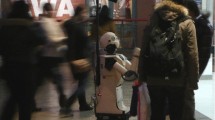Abstract
Recent research in mobile robot navigation make it feasible to utilize autonomous robots in service fields. But, such applications require more than just navigation. To operate in a peopled environment, robots should recognize and act according to human social behavior. In this paper, we present the design and implementation of one such social behavior: a robot that stands in line much as people do. The system employs stereo vision to recognize lines of people, and uses the concept of personal space for modeling the social behavior. Personal space is used both to detect the end of a line and to determine how much space to leave between the robot and the person in front of it. Our model of personal space is based on measurements from people forming lines. We demonstrate our ideas with a mobile robot navigation system that can purchase a cup of coffee, even if people are waiting in line for service.
Similar content being viewed by others
References
Brunelli, R. and Poggio, T. 1995. Template matching: Matched spatial filters and beyond. M.I.T., Cambridge, MA, A.I. Memo, 1536.
Fitzgibbon, A.W., Pilu, M., and Fisher, R.B. 1996. Direct least square fitting of ellipses. Department of Artif. Intell., The University of Edinburgh, Scotland, DAI Research Paper 794.
HelpMate Robotics Inc., http://users.ntplx.net/~helpmate.
Illingworth, J. and Kittler, J. 1988. A survey of the Hough transform. Computer Vision, Graphics, and Image Processing, 44:87–116.
Koenig, S., Goodwin, R., and Simmons, R. 1996. Robot navigation with Markov models: A framework for path planning and learning with limited computational resources. In Reasoning with Uncertainty in Robotics, Lecture Notes in Artificial Intelligence, vol. 1093, Dorst, van Lambalgen and Voorbraak (Eds.), Springer: Berlin, pp. 322–337.
Konolige, K. 1997. Small vision systems: Hardware and implementation. In Proc. Eighth International Symposium on Robotics Research.
Malmberg, M. 1980. Human Territoriality: Survey of Behavioural Territories in Man with Preliminary Analysis and Discussion of Meaning, Mouton Publishers.
Matsui, T. et al. 1997. An office conversation mobile robot that learns by navigation and conversation. In Proc. of RealWorld Computing Symposium, pp. 59–62.
Nakauchi, Y. and Simmons, R. 1999. Social behavioral robot that stands in line. In Proc. of IEEE SMC, pp. II-993–998.
Oren, M., Papageorgiou, C., Shinha, P., Osuna, E., and Poggio, T. 1997. A trainable system for people detection. In Proc. of Image Understanding Workshop, pp. 207–214.
Rosin, P.L. 1993. Anote on the least square fitting of ellipses. Pattern Recognition Letters, 14:799–808.
Rowley, H., Baluja, S., and Kanade, T. 1998. Neural network-based face detection. In Proc. of IEEE PAMI.
Sack, R. 1986. Human Territoriality. Cambridge University Press: Cambridge, UK.
Simmons, R., Goodwin, R., Zita Haigh, K., Koenig, S., and O'Sullivan, J. 1997. A layered architecture for office delivery robots. In Proc. of Autonomous Agents, pp. 245–252.
Thrun, S. et al., 1999. MINERVA: A second generation mobile tour-guide robot. In Proc. of IEEE ICRA'99.
Author information
Authors and Affiliations
Rights and permissions
About this article
Cite this article
Nakauchi, Y., Simmons, R. A Social Robot that Stands in Line. Autonomous Robots 12, 313–324 (2002). https://doi.org/10.1023/A:1015273816637
Issue Date:
DOI: https://doi.org/10.1023/A:1015273816637




